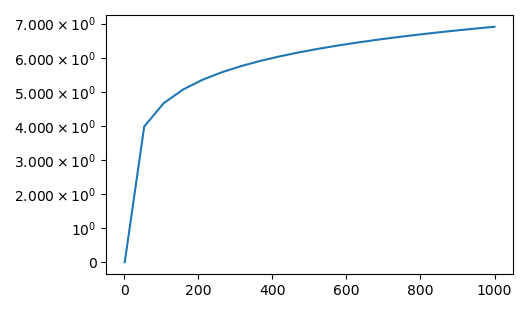Libraries
Matplotlib的基本使用
字体和Unicode使用
import matplotlib.pyplot as plt
import matplotlib
import numpy as np
import matplotlib.ticker as mtick
plt.rcParams["axes.labelsize"] = 16
plt.rcParams["xtick.labelsize"] = 15
plt.rcParams["ytick.labelsize"] = 15
plt.rcParams["axes.titlesize"] = 15
plt.rcParams['legend.fontsize'] = 15
plt.rcParams['font.family'] = 'serif'
plt.rcParams['font.serif'] = ['Times New Roman'] + plt.rcParams['font.serif']
fig = plt.figure(figsize=(7,5))
ax = fig.add_subplot(111)
T = np.linspace(273.15, 1000.0, 100)
y1 = 1.0 * np.exp(-210000/8.31451/T)
y2 = 1.0 * np.exp(-220000/8.31451/T)
y3 = 1.0 * np.exp(-230000/8.31451/T)
line1, = ax.plot(T, y1, label="Diffusion coefficient - 1", color="#278740", marker="d", linestyle="-", linewidth=2, markevery=4)
line2, = ax.plot(T, y2, label="Diffusion coefficient - 2", color="#B330EE", marker="s", linestyle="-", linewidth=2, markevery=4)
line3, = ax.plot(T, y3, label="Diffusion coefficient - 3", color="#00635D", marker="o", linestyle="-", linewidth=2, markevery=4)
ax.set_xlabel("Temperature, K")
# for subscripts and superscript: https://blog.csdn.net/ToraNe/article/details/102883856
ax.set_ylabel("Diffusion coefficient, m\u00b2 /s")
ax.yaxis.set_major_formatter(mtick.ScalarFormatter(useMathText=True))
ax.set_xlim([273.15, 1000.0])
plt.legend()
plt.tight_layout()
plt.savefig("figure.png", dpi=300)
自定义的坐标轴刻度标签

import matplotlib.pyplot as plt
from matplotlib.ticker import ScalarFormatter
import numpy as np
import matplotlib.ticker as ticker
def customFormatter(value, _):
if abs(value) > 1.0e-10:
if value < 0:
sign = '-'
value *= -1
else:
sign = ''
exponent = int(np.floor(np.log10(value)))
multiplier = value / (10 ** exponent)
if multiplier % 1 < 0.0000001:
multiplier = int(multiplier)
if multiplier == 1:
label = str((r'$%s%s^{%d}$') % (sign, 10, exponent))
else:
label = str((r'$%s%.3f\times%s^{%d}$') % (sign, multiplier, 10, exponent))
else:
label = str('{0:g}'.format(value))
return label
x = np.linspace(1.0, 1000.0, 20)
y = np.log(x)
fig, ax = plt.subplots()
ax.plot(x, y)
ax.yaxis.set_major_formatter(ticker.FuncFormatter(customFormatter))
plt.tight_layout()
plt.show()
仅生成colorbar
import matplotlib.pyplot as plt
import matplotlib as mpl
def make_colorbar(vmin, vmax, dest):
# fig, ax = plt.subplots(figsize=(1.0, 1.0))
fig = plt.figure(figsize=(0.8, 1.2))
# ax = fig.add_subplot(111)
norm = plt.Normalize(vmin, vmax)
# 创建一个用于colorbar的线性归一化对象
norm = mpl.colors.Normalize(vmin=vmin, vmax=vmax)
# 创建colorbar
cbar = fig.colorbar(mpl.cm.ScalarMappable(norm=norm, cmap='viridis'),
cax=plt.axes([0.1, 0.1, 0.2, 0.8]),
orientation='vertical')
plt.savefig(dest, dpi=300, bbox_inches="tight")
plt.clf()
plt.close()
# plt.show()
if __name__ == "__main__":
make_colorbar(0, 1, "fields/colorbar.svg")
make_colorbar(0, 0.3, "fields/colorbar-composition.svg")
放大图中的局部内容
import matplotlib.pyplot as plt
fig = plt.figure(figsize=(3, 2))
ax = fig.add_subplot(111)
axins = ax.inset_axes([0.5, 0.10, 0.4, 0.4], xticklabels=[], yticklabels=[])
ax.plot([1, 2, 3, 4, 5, 6, 7, 8], [1, 2, 3, 4, 5, 6, 7, 8], label="main")
axins.plot([1, 2, 3], [1, 2, 3], label="inset")
ax.indicate_inset_zoom(axins, edgecolor="black")
ax.set_xlabel("Time, s")
ax.set_ylabel("Fraction")
plt.tight_layout()
plt.show()